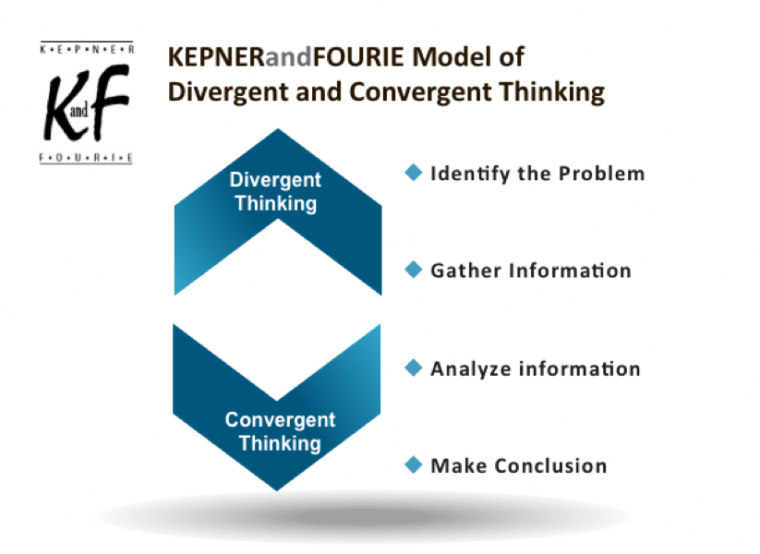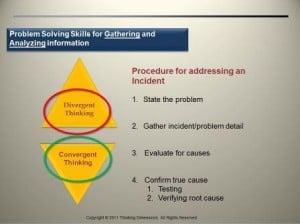
“We thought that we had the answers, it was the questions we had wrong.”
Edward de Bono
What Edward de Bono had to say rings very true with a high percentage of the problems that we are presented with, if the right questions are asked at the outset of the process it can save you a great deal of time and a lot of unnecessary tears and frustration.
Invariably the question is “Where do we start?”

The Divergent and Convergent Process
As in the above graphic we start by encouraging the group/team to “State the Problem”, in other words identify what the specific problem is that needs resolving. This is not as simple as it sounds and yet is it important at the outset of the process to set the tone, ensure you get to the core of the problem and to have developed an agreed problem statement before you move to the next phase.
The above graphic illustrates a process that we have used successfully for over 15 years to solve problems and provide workable solutions for individuals and organisations. It may not look like much but the underlying techniques and processes if adopted will help to clarify areas that have appeared vague and elusive on the way to providing you with a solution.
I want to concentrate on the “state the problem” issue and give you some insight into why it is so important that you get it right at the outset and you have consensus from all the members of the team. It might seem like you are spending an unwarranted amount of time on a problem that you already have identified and are sure you are well on the way to a solution.
It is important that every member of the team buys in on the problem statement at the outset, it will save a lot of “but I didn’t agree to that” later on. The easiest way to explain getting to the stage where you can safely agree that you have been able to “state the problem “ is to work through an example and illustrate some of the questioning techniques that we use along the way.
The original “state the problem” was – My workstation is not able to print documents
This is probably a statement that IT technicians hear every day and those that are worth their salt will probably ask a few well directed queries before offering a solution.
This is where a 19h century English writer comes to our aid with 6 wise men; yes Rudyard Kipling is supplying the basis for our questioning techniques
I keep six honest serving-men:
(They taught me all I knew)
Their names are What and Where and When
And How and Why and Who.
It is these 6 words that will help us to qualify the problem and evolve the problem statements.
In the above case we might take the following train of questioning?
- What workstation was unable to print?
The marketing workstation
- When is the marketing workstation unable to print?
It prints fine to all printers except when a colour print or image is requested
- What happens to the printer when you send a job to it?
The printer will print text and images in black and white but not in colour.
From these 3 questions we can now “State the Problem” with a great deal more accuracy and the chances of us solving the problem effectively and efficiently with the optimum use of our resources.
Before we move on, check your thinking by posing the rephrased problem statement to the original complainant.
So the original problem statement was
- My workstation is not able to print documents
and the reworked problem statement became;
- The marketing workstation is unable to print colour.
If only we could start all the problems we are asked to solve with a detailed and specific statemant of the problem I am convinced we could drastically reduce the time required to resolve issues. It is not just a case of empowering the problem solver to ask the right questions but also to get the users to provide accurate and relevant information about the problem.



